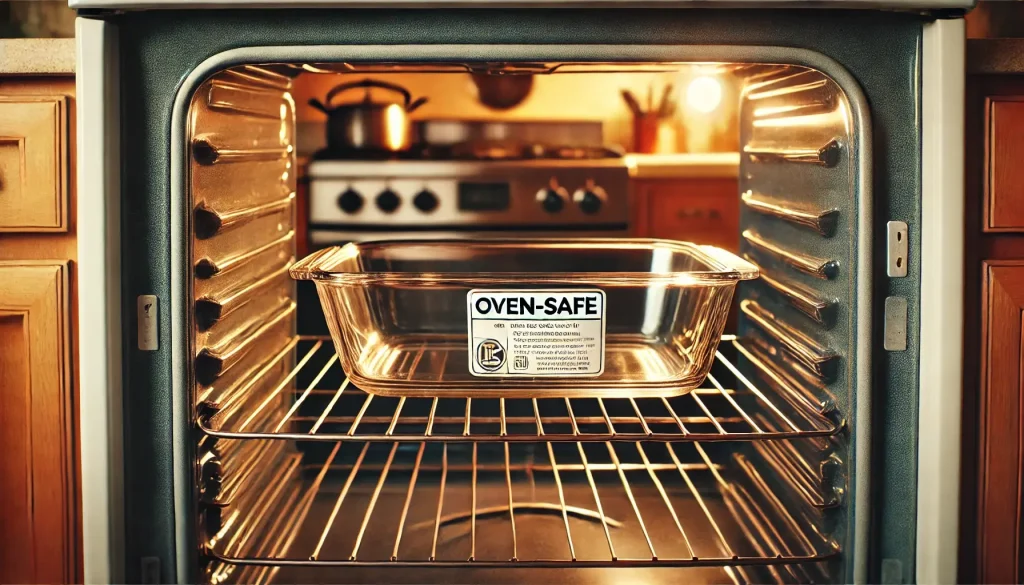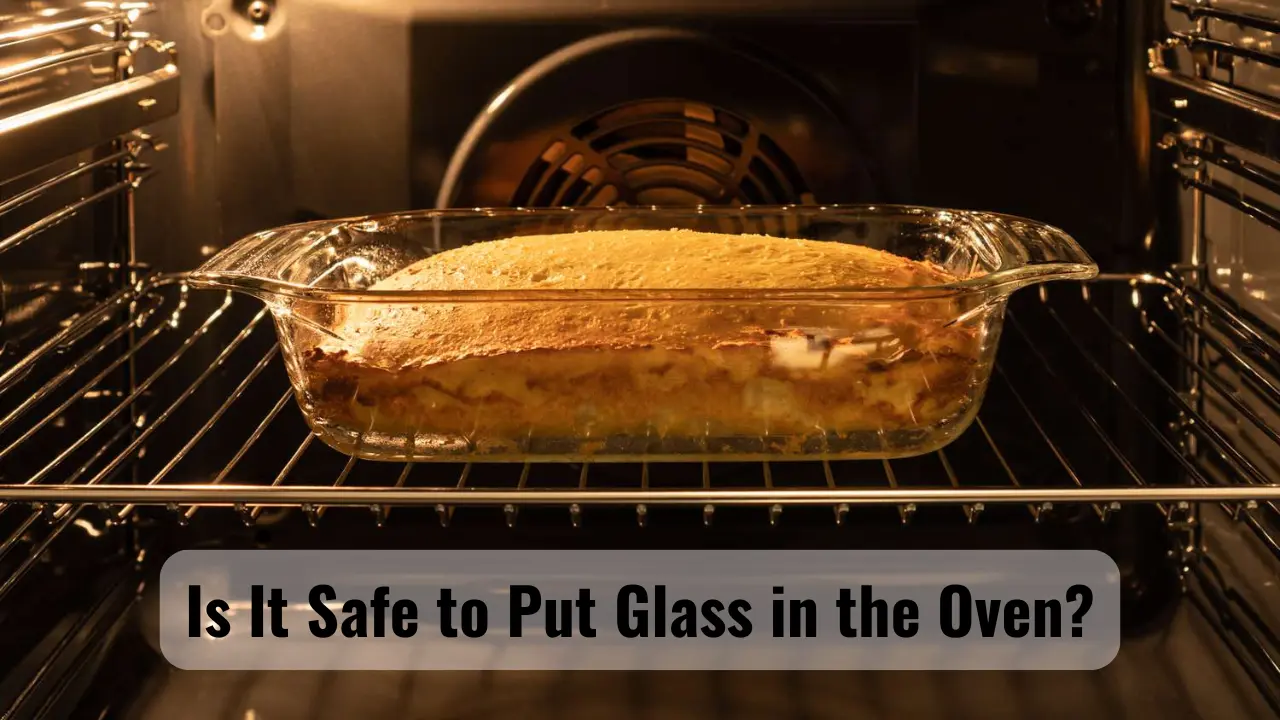Yes, it is safe to put certain types of glass in the oven. But, not all glass is oven-safe.
Many people wonder about cooking with glass cookware. Glass can crack or shatter if not designed for oven use. In this blog, we will explore which types of glass are safe. We will also discuss how to use them correctly.
This helps you avoid any accidents. Understanding these details ensures your safety and successful cooking. Let’s dive into what you need to know about using glass in the oven.
How Do You Know If Glass Is Oven Safe?
To know if the glass is oven-safe, check for an “oven-safe” label on the bottom or packaging.
Tempered glass, like Pyrex or borosilicate glass, is designed to handle high temperatures, while regular glass may crack or shatter due to heat.
If unsure, refer to the manufacturer’s guidelines and avoid exposing the glass to sudden temperature changes.

Glassware Types
Hey friends, today we are diving into the world of glassware. Specifically, the types that can be safely used in your oven. Not all glass is the same. Some are designed to withstand high temperatures, while others can shatter if heated. Let’s explore the two main types: Tempered Glass and Borosilicate Glass.
Tempered Glass
Tempered glass is one of the most common types of glassware. It’s used in many households for baking dishes and storage containers. Why? Because it’s tough. It goes through a special process where it is heated and then cooled quickly. This makes it stronger than regular glass.
- Pros:
- Very strong and durable
- Less likely to break or shatter
- Cons:
- Can still break if it experiences a sudden change in temperature
- Not as heat-resistant as borosilicate glass
Remember my first attempt at baking lasagna? I used a tempered glass dish. It worked great. Just be careful when moving it from the fridge to the oven. Sudden temperature changes can be risky.
Borosilicate Glass
Borosilicate glass is another type you might encounter. It’s often used in laboratory glassware and high-quality kitchen items. This glass contains boron, which makes it resistant to extreme temperatures. Think of it like a superhero among glassware.
- Pros:
- Can handle high temperatures
- Less likely to crack under thermal stress
- Cons:
- More expensive than tempered glass
- May not be as readily available
Last year, I baked a cake in a borosilicate glass dish. It came out perfectly. No cracks, no breaks. If you bake often, investing in borosilicate glassware could be worth it.
In summary, both tempered and borosilicate glass have their advantages. It depends on what you need. For general use, tempered glass is fine. For high-heat cooking, consider borosilicate. Choose wisely, and happy baking!
Oven-safe Labels
Understanding oven-safe labels is crucial for safely using glassware in your oven. These labels help you identify which glass items can withstand oven temperatures. Always check for these labels to avoid accidents and damage.
Manufacturer Instructions
Manufacturers often provide specific instructions for their glassware. These guidelines tell you the maximum temperature the glass can handle. Always read these instructions before using the glass in your oven. Ignoring them can lead to cracks or breaks.
Common Symbols
Oven-safe glassware usually has symbols printed on them. A common symbol is a small oven icon. This icon indicates the glass can be used in an oven. Another symbol to look for is a temperature range. This shows the safe temperatures for the glass. Recognizing these symbols ensures safer cooking practices.
Heat Resistance
Hey friends, today we’ll explore if it’s safe to put glass in the oven. One of the big factors to consider is heat resistance. You see, not all glass is made the same. Some can handle high temperatures, while others can’t. Let’s break it down into simple terms.
Temperature Limits
Most oven-safe glassware can withstand a wide range of temperatures. Typically, they can handle up to 450°F (232°C). But always check the manufacturer’s guidelines. Why? Because if the glass can’t handle the heat, it might break. Imagine putting a delicate wine glass in the oven. Not a good idea, right? Same goes for non-oven-safe glass.
- Check the label or manual
- Stick to the recommended temperature range
- When in doubt, don’t use it
Thermal Shock
Now, let’s talk about thermal shock. Sounds fancy, but it’s simple. Thermal shock happens when glass is exposed to sudden temperature changes. Imagine taking a hot dish from the oven and putting it in cold water. The glass can crack or shatter. This happens because the glass expands and contracts too quickly.
How to avoid it? Here’s a quick list:
- Preheat the oven with the glass inside
- Let glass cool naturally before washing
- Avoid sudden temperature changes
In short, knowing the heat resistance of your glassware can save you from a kitchen disaster. Stick to the guidelines, and you’ll be cooking safely in no time. Happy baking!

Credit: www.reddit.com
Preparation Techniques
Hey friends, today we’re diving into the topic of putting glass in the oven. It’s something many of us wonder about, right? Like, is it really safe? The good news is, it can be, but there are some preparation techniques you need to follow to keep things safe. Let’s talk about those.
Gradual Heating
One of the most important things to remember is to heat the glass gradually. You don’t want to shock it with sudden temperature changes. Think of it like getting into a hot bath. You wouldn’t jump in right away, would you? You’d ease in slowly.
Here’s how you can do it:
- Start with a cold oven. Place your glass dish inside before turning on the heat.
- Set the oven to a low temperature, then gradually increase it. This helps the glass adjust without cracking.
- Always follow the manufacturer’s instructions. They know best!
By doing this, you reduce the risk of the glass breaking. Trust me, I’ve learned this the hard way. Once, I tried to bake a lasagna in a glass dish by preheating the oven first. Big mistake. The dish cracked, and I was left cleaning up a cheesy mess.
Avoid Cold Surfaces
Another key tip is to avoid placing hot glass on cold surfaces. This sudden temperature change can cause the glass to shatter. Imagine pouring hot coffee into a cold glass. Not a good idea, right? The same logic applies here.
Here’s what you can do:
- When you take the glass out of the oven, place it on a wooden cutting board or a towel. This helps buffer the temperature change.
- Let the glass cool down slowly. Don’t rush it by putting it in the fridge or running cold water over it.
- Be patient. It’s worth it to avoid a mess.
I remember my aunt once baked a pie in a glass dish. She put it on a cold marble countertop right out of the oven. Boom! The dish shattered, and pie was everywhere. We had to order pizza instead. Lesson learned.
So, following these simple preparation techniques can help you safely use glass in the oven. Gradual heating and avoiding cold surfaces are key. Give it a try and let me know how it goes. Happy baking!
Signs Of Damage
Hey folks, today we’re diving into a crucial topic: identifying damage on your glassware before putting it in the oven. Damaged glass can be dangerous. So, let’s learn how to spot the signs of damage and ensure your safety.
Cracks And Chips
First things first. Always look for cracks or chips. Even small ones can lead to big issues. Think of a tiny crack as a weak spot. When exposed to oven heat, this weak spot can cause the glass to break.
- Examine the edges and surface closely.
- Run your fingers gently over the glass to feel for any chips.
- If you find any, it’s best not to use that piece in the oven.
I once put a chipped glass dish in the oven, thinking it would be fine. Spoiler alert: it shattered. Trust me, you don’t want to clean up that mess.
Discoloration
Next, let’s talk about discoloration. Over time, glass can change color. This can be a sign of wear and tear.
- Look for any cloudy or foggy areas.
- Check for any unusual colors like yellow or brown spots.
Discoloration can mean the glass isn’t as strong as it used to be. It’s like a warning sign. So, if you see any, think twice before using that glass in the oven.
In summary, always check your glassware for cracks, chips, and discoloration. It only takes a few minutes but can save you from a dangerous situation. Stay safe and happy cooking!
:max_bytes(150000):strip_icc()/Can-You-Put-Glass-in-Oven-4x3-55db0e6abc674eafb6be44e46bf4285e.jpg)
Credit: www.allrecipes.com
Cleaning Tips
Cleaning glass cookware is essential for maintaining its safety and longevity. Proper cleaning ensures that the glass remains free from residues that might affect its performance. Here are some cleaning tips to help you keep your glass cookware in top condition.
Safe Cleaning Products
Use mild dish soap for cleaning glass cookware. Gentle cleaners help avoid damage. Look for products labeled as safe for glass. Vinegar and baking soda are also effective. Mix them with water for a simple, safe cleaning solution. Always rinse thoroughly after washing.
Avoiding Abrasives
Avoid using abrasive sponges or harsh chemicals. They can scratch and weaken the glass. Opt for soft cloths or non-abrasive sponges. Scratches can lead to cracks over time. Also, stay clear of steel wool and rough scrubbers. Gentle materials keep your glass cookware safe.
Alternative Materials
Hey friends, today we’re talking about something many of you might be curious about: alternative materials to use in the oven. You might wonder if glass is always the best choice. Sometimes, it isn’t. There are other materials that can be safer or more convenient. Let’s dive into some of these options.
Metal Bakeware
First up, metal bakeware. It’s a classic choice for many reasons. It’s durable and can handle high temperatures without breaking a sweat. Plus, it heats up quickly and evenly, which means your food cooks faster.
- Pros: Durable, even cooking, heats up quickly.
- Cons: Can be heavy, not suitable for microwave use.
Imagine this: You’re baking cookies and need them ready in a jiffy. Metal bakeware is your go-to. I recently baked a batch of chocolate chip cookies, and they turned out perfect—crispy on the edges and chewy in the middle.
Silicone Molds
Another great option is silicone molds. These are flexible, making it super easy to pop out your baked goods. They are also non-stick, so you don’t need to grease them much.
- Pros: Flexible, non-stick, easy to clean.
- Cons: Not suitable for very high temperatures, can be less durable.
Picture this: You’re making cupcakes for a party. Silicone molds are a breeze to use. Just pour the batter, bake, and pop them out. They turn out perfect every time. And cleaning up? A piece of cake!
So there you have it. Whether you choose metal bakeware or silicone molds, each has its own benefits and drawbacks. The key is to pick what works best for your needs. Next time you’re baking, think about giving one of these alternatives a try. Happy baking!

Credit: www.reddit.com
Emergency Steps
Accidents happen, especially in the kitchen. If glass breaks in the oven, stay calm. Follow these emergency steps to handle the situation safely. Let’s dive into the essentials.
Handling Breakage
If glass shatters in the oven, turn it off immediately. Allow the oven to cool completely before doing anything. Never touch broken glass with bare hands. Use gloves to protect yourself.
Carefully remove large pieces of glass. Use tongs for better control. For smaller shards, use a wet cloth or vacuum designed for glass cleanup. Dispose of the glass safely in a thick, sealed bag.
Preventing Burns
Heat can cause burns. Always let the oven cool before cleaning. Use oven mitts to protect your hands. Avoid reaching into the oven with your bare skin.
If you do get burned, treat the area immediately. Run cool water over the burn. Avoid using ice. Seek medical help if necessary.
Frequently Asked Questions
How Do You Know If Your Glass Is Oven-safe?
Check for an oven-safe symbol on the glassware. Look for labels like “oven-safe” or “heat-resistant. “
What Happens If Glass Goes In The Oven?
Glass can crack or shatter in the oven if not oven-safe. Always use oven-safe glassware to avoid accidents.
Can I Put Glass In The Baking Oven?
Yes, you can put glass in the baking oven if it is labeled oven-safe. Check manufacturer guidelines for safety.
What Glass Is Not Oven-safe?
Glass not labeled as oven-safe, such as regular drinking glasses or decorative glassware, should not be used in ovens.
Conclusion
It’s safe to put glass in the oven if it’s oven-safe. Always check for labels or markings. Use caution with sudden temperature changes. Avoid placing cold glass directly into a hot oven. Always follow the manufacturer’s instructions. Taking these steps ensures safe cooking with glassware.
Enjoy your baking and cooking adventures with confidence!

